Scaffolding Companies Tucson Estates
Find the best Scaffolding Builders in Tucson Estates
Get multiple Scaffolding Company quotes for your project today! Compare profiles, reviews, accreditations, portfolio, etc... and choose the best deal.
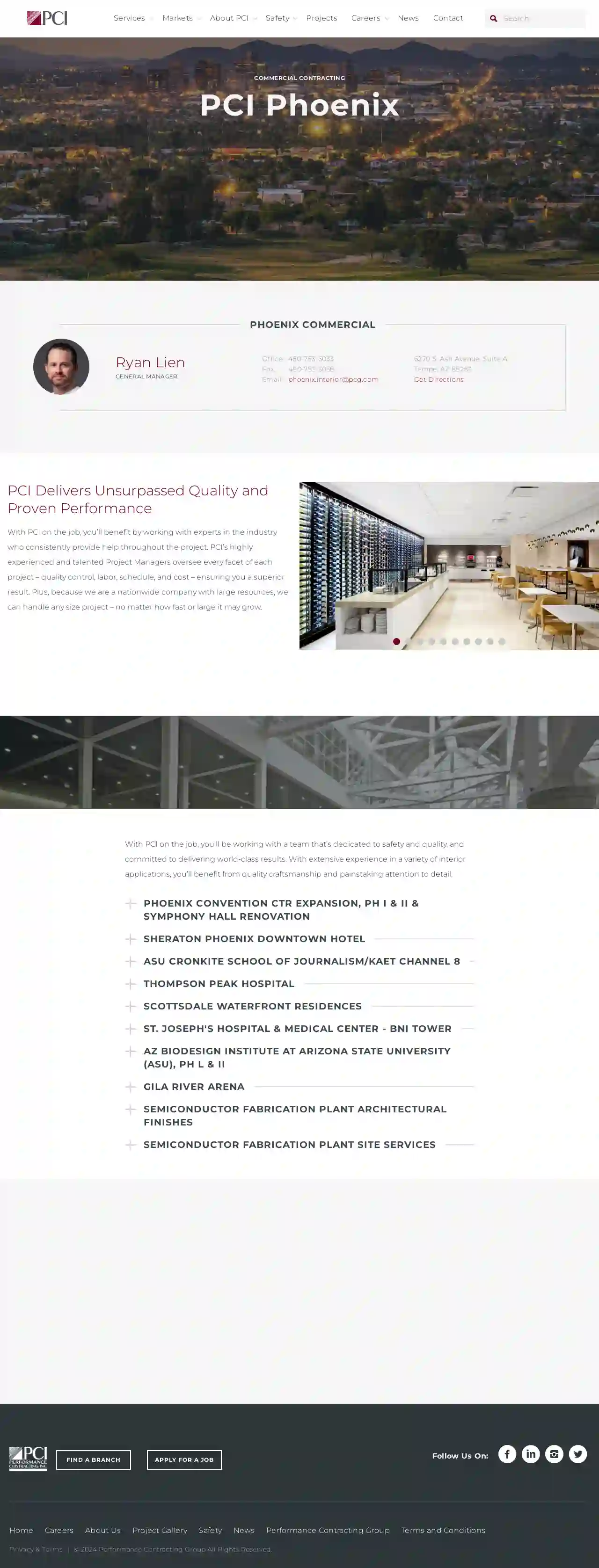
Performance Contracting Inc
419 reviewsTempe, AZ, 6270 S. Ash Avenue, Suite A, Phoenix, 85283, USPerformance Contracting, Inc. is a top-tier specialty contractor in the United States, providing exceptional services and products to industrial, commercial, and non-residential sectors. With a wide range of related services, PCI establishes itself as a true 'one-stop-shop' contractor, ensuring customers receive comprehensive solutions tailored to their specific needs.
- Services
- Why Us?
- Accreditations
- Our Team
- Testimonials
- Gallery
Get Quote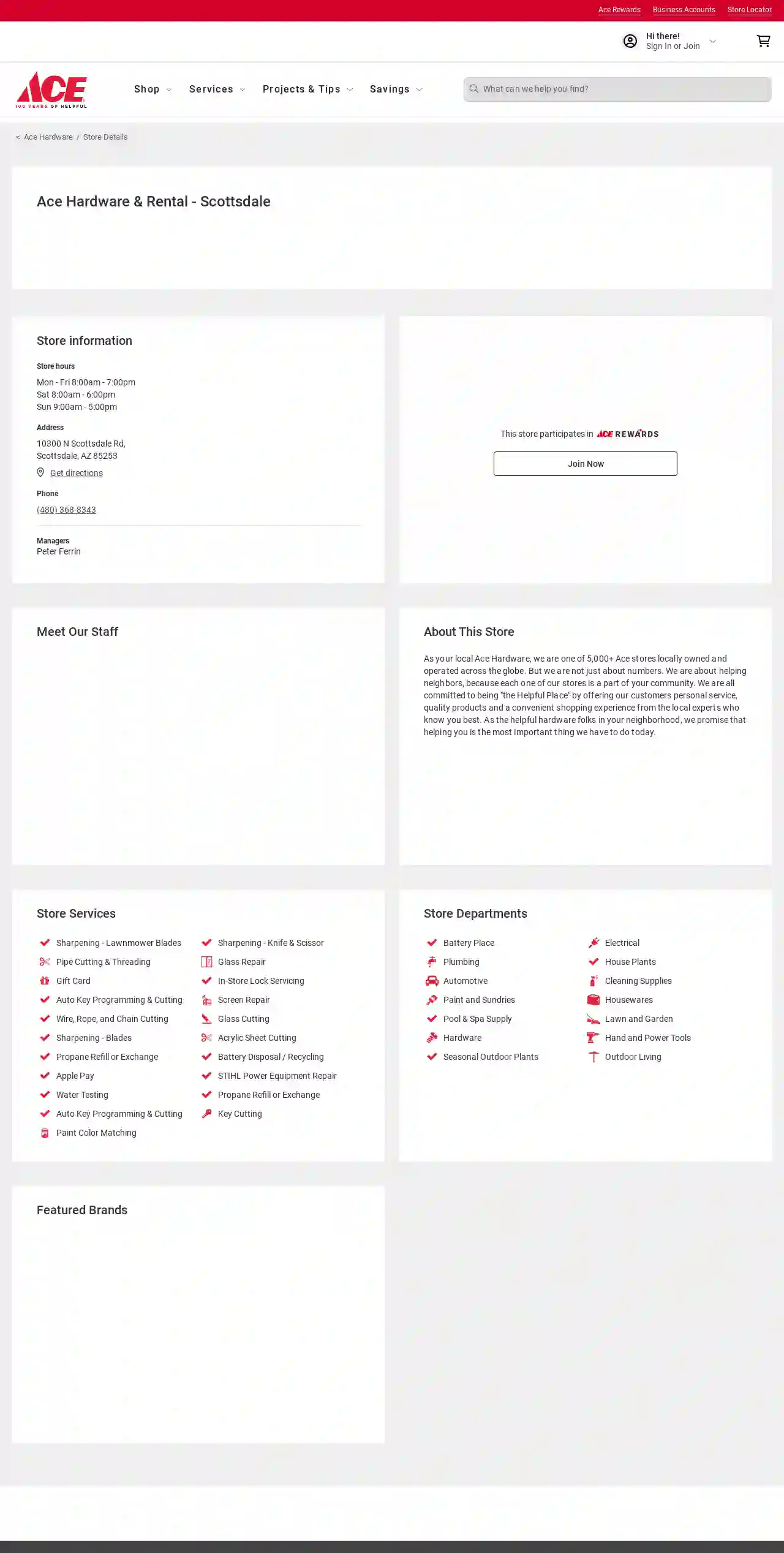
Ace Hardware & Rental - Scottsdale
4.4227 reviews10300 N Scottsdale Rd, Scottsdale, 85253, USAt Ace Hardware, we're more than just a hardware store. We're your local experts, committed to helping neighbors like you with quality products, personal service, and a convenient shopping experience. As one of over 5,000 Ace stores globally, we're proud to be a part of your community. Our mission is to be 'the Helpful Place' by offering expert advice, a wide selection of products, and a commitment to customer satisfaction. Whether you're a homeowner, DIY enthusiast, or contractor, we're here to help you get the job done right.
- Services
- Why Us?
- Our Team
- Gallery
Get Quote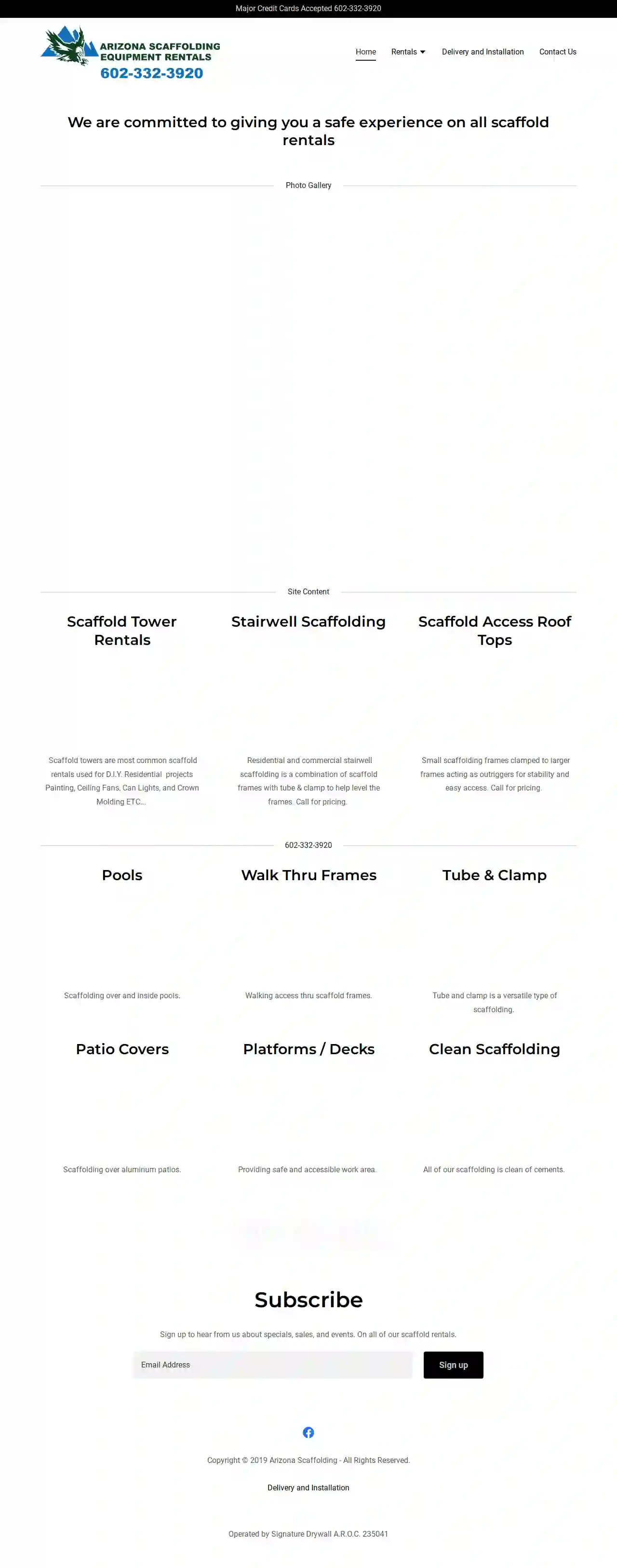
Arizona Scaffolding
47 reviews3087 E Pecos Rd, Phoenix, 85048, USArizona Scaffolding is a leading provider of safe and accessible scaffolding solutions for residential and commercial projects. With a commitment to safety and customer satisfaction, they offer a range of services including scaffold tower rentals, stairwell scaffolding, and access to roof tops. Their team is dedicated to providing clean and well-maintained scaffolding equipment, ensuring a hassle-free experience for clients. Arizona Scaffolding serves various cities and offers delivery and installation services for all their products.
- Services
- Why Us?
- Accreditations
- Gallery
Get Quote
Farwest Insulation Contracting
4.85 reviewsTucson, AZ, 3171 East District Street, 85714, USFarwest Insulation Contracting is a privately held family business specializing in Commercial & Industrial Mechanical Insulation, Scaffolding, Painting & Industrial Coatings, Firestopping, Asbestos Abatement, and Electric Heat Tracing. The company was incorporated on September 11, 2003, and began operations on December 17, 2004 after acquiring the operating assets of Thorpe Insulation Company. Thorpe Insulation was founded in 1948 in Southern California and quickly established itself as the premier insulation contractor on the West Coast. Today, the company employs more than 300 employees across the Southwestern United States.
- Services
- Why Us?
- Accreditations
- Our Team
- Testimonials
- Gallery
Get Quote
Vault Scaffold
43 reviewsMaryland, USWelcome to Vault Scaffold Vault Scaffold is proud to offer the finest Scaffolding in the World, UpRight Scaffold. Don’t settle for less: UpRight Scaffold is the Original, is the safest and utilizes the finest Irish Craftsmanship in every piece made. Still the world innovator in Aluminum Scaffold, Vault Scaffold with UpRight Scaffold is the Choice of CFO’s, CEO’s, Safety managers and front line workers for its light weight, ease of use, safety features and for its 70 year track record of providing the safest Aluminum Scaffold in the world. We have multiple warehouses to ship from, so your order arrives quickly, and most orders ship within 24 hours. Parts order usually ship the same day. Original Upright Parts or Original Vault parts, we have the stock for your field repair needs. Custom designs are not a problem as we offer design and engineering solutions to all of your high reach tower needs. Call us today to discuss your needs.
- Services
- Why Us?
- Gallery
Get Quote
JT Thorpe
511 reviews1060 Hensley Street, Richmond, 94801, USJT THORPE is your trusted partner for comprehensive solutions in refractory, scaffolding, fireproofing, insulation, and more. With over 100 years of industry experience, we deliver exceptional results with unmatched expertise and commitment to quality. Experience the JT THORPE difference: 100+ years of proven expertise in softcraft solutions, combined with cutting-edge technology and unwavering commitment to safety, quality, and reliability.
- Services
- Why Us?
- Gallery
Get Quote
Sunbelt Rentals
4.271 reviewsTucson, USSunbelt Rentals: Your One-Stop Shop for Equipment Rentals Sunbelt Rentals is a leading provider of equipment rentals in the United States and Canada. We offer a wide variety of equipment for rent, including aerial work platforms, scaffolding, ladders, cranes, boom trucks, scissor lifts, low-level access, manlifts, and more. Whether you're a homeowner tackling a DIY project or a contractor working on a large-scale construction project, Sunbelt Rentals has the equipment you need to get the job done right. We're committed to providing our customers with the best possible experience. That's why we offer a wide range of services, including: 24/7 customer support Fast and reliable delivery Competitive pricing Expert technical support We also have a team of experienced professionals who can help you choose the right equipment for your needs. Contact us today to learn more about our services and how we can help you succeed.
- Services
- Why Us?
- Gallery
Get Quote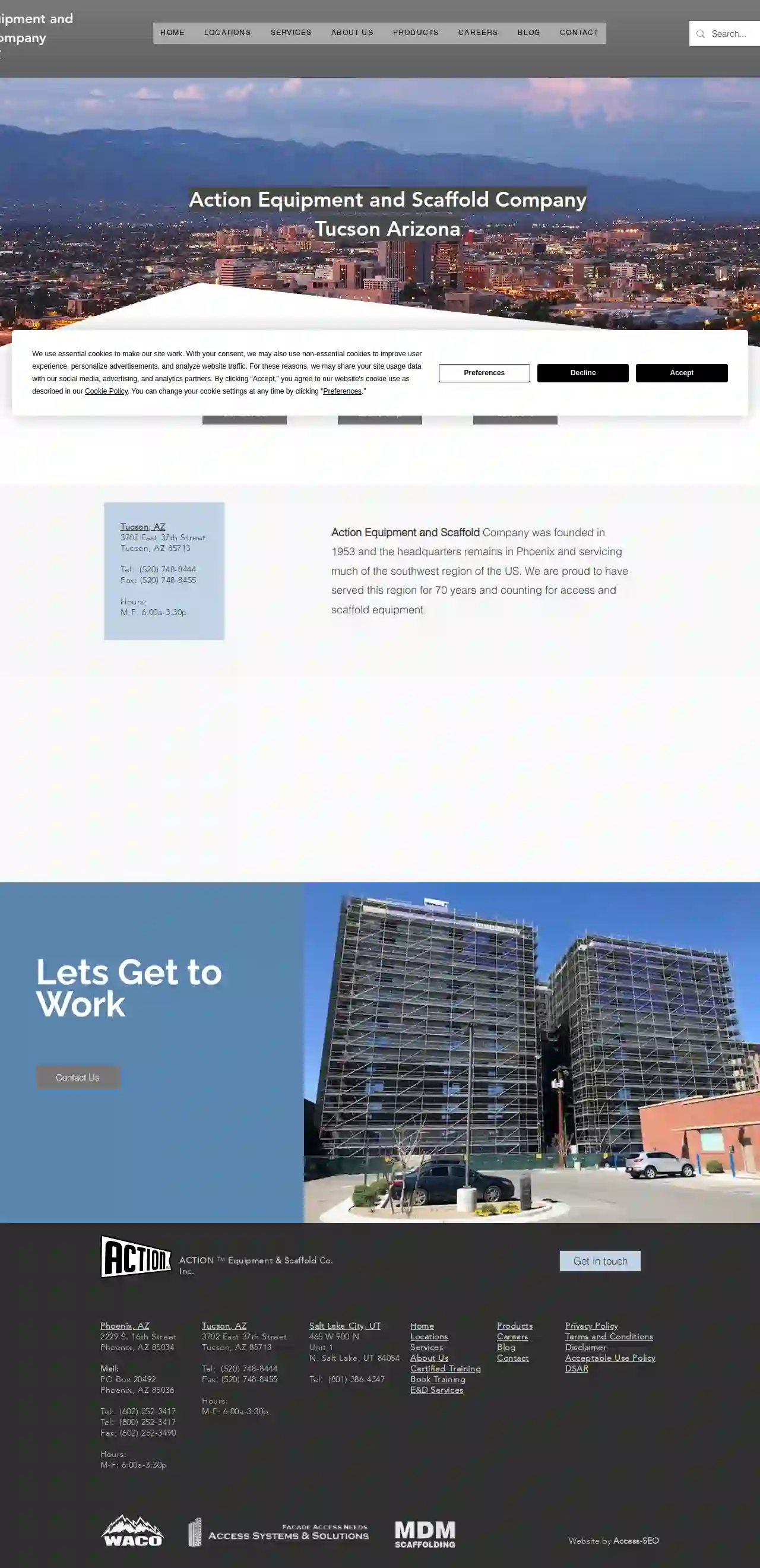
Action Equipment and Scaffold Company
4.622 reviews3702 East 37th Street, Tucson, 85713, USAction Equipment and Scaffold Company Action Equipment and Scaffold Company was founded in 1953 and the headquarters remains in Phoenix, Arizona. We are proud to have served the southwest region of the US for over 70 years, providing access and scaffold equipment. Our commitment to quality and safety has made us a trusted partner for businesses of all sizes. We offer a wide range of services, including: Erect and dismantle scaffolding Industrial scaffolding Certified safety training Our team of experienced professionals is dedicated to providing our clients with the highest level of service. We are committed to safety, quality, and customer satisfaction. Contact us today to learn more about our services and how we can help you with your next project.
- Services
- Why Us?
- Gallery
Get Quote
SDB Contracting Services
4.431 reviews123 Main St, Anytown, USA, 12345, USSDB Contracting Services is a solutions-oriented service provider that specializes in crating and rigging services. With a focus on growth and opportunity, the company offers a range of services tailored to meet the needs of its clients. From general to specialized services, SDB ensures that all projects are completed with precision and professionalism. The company's mission is to provide top-notch solutions that enhance the quality of life for its clients and the community.
- Services
- Why Us?
- Accreditations
- Our Team
- Testimonials
- Gallery
Get Quote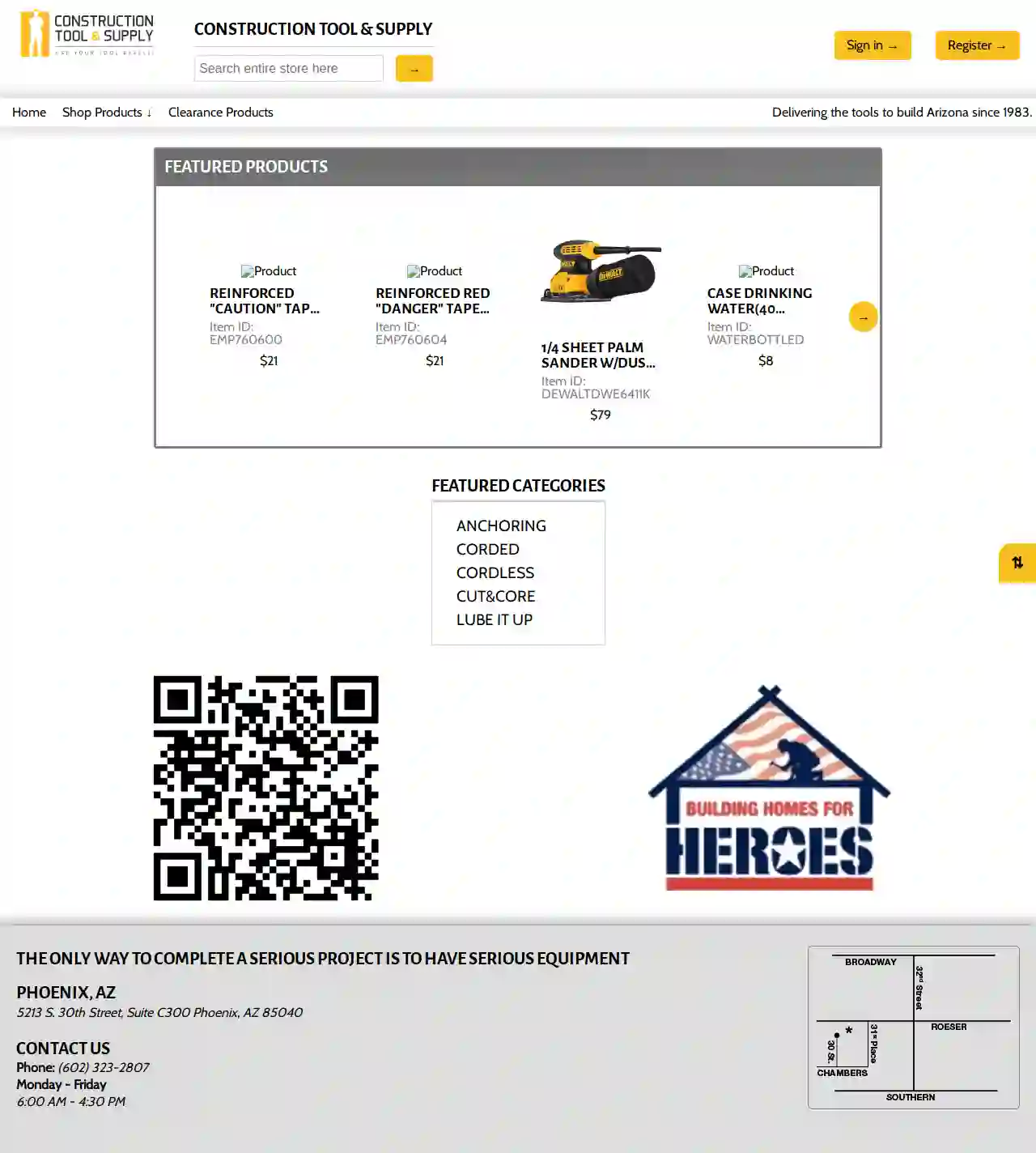
Construction Tool & Supply
564 reviews123 Main Street, Phoenix, 85001, USAbout Construction Tool AZ Construction Tool AZ is your one-stop shop for all your construction tool needs. We offer a wide selection of high-quality tools from top brands at competitive prices. Our knowledgeable staff is always available to help you find the right tools for your project. We are committed to providing our customers with the best possible service and support. We are a family-owned and operated business with over 10 years of experience in the construction industry. We understand the importance of having the right tools for the job, and we are dedicated to helping our customers succeed. We offer a variety of services to meet your needs, including tool rental, tool repair, and tool sales. We also offer free delivery and pick-up services for our customers in the Phoenix area. We are committed to providing our customers with the best possible service and support. We are a family-owned and operated business with over 10 years of experience in the construction industry. We understand the importance of having the right tools for the job, and we are dedicated to helping our customers succeed.
- Services
- Why Us?
Get Quote
Over 2,353+ Scaffolding Companies registered
Our scaffolding pros operate in Tucson Estates and beyond!
ScaffoldingHQ has curated and vetted the Best Scaffolding Businesses near Tucson Estates. Find a trustworthy contractor today.
Frequently Asked Questions About Scaffolding Companies
- Experience: 'How long have you been in business, and what experience do you have with projects like mine?'
- Licensing and Insurance: 'Are you fully licensed and insured, and can I see proof of coverage?'
- Safety Record: 'What are your safety procedures, and how do you ensure worker safety on the job site?'
- References: 'Can you provide references from previous clients?'
- Quotes and Costs: 'Can you provide a detailed quote that outlines all costs, including materials, labor, and any additional services?'
- Project Timeline: 'What is the estimated timeframe for scaffolding erection and dismantling?'
- Communication: 'How will you communicate with me throughout the project?'
- Hire Professionals: Just like erection, dismantling should be done by qualified and experienced scaffolding erectors.
- Reverse the Erection Process: The dismantling process should generally follow the reverse order of erection.
- Clear the Area: Ensure the area below is free from people and obstacles.
- Lower Materials Safely: Use ropes or other safe methods to lower dismantled components to the ground.
- Inspect Components: As components are removed, inspect them for damage and store them properly for future use.
- Always Wear a Safety Harness: Connect your harness to a secure anchor point at all times to prevent falls.
- Keep Platforms Clear: Remove tools, materials, and debris to avoid tripping hazards.
- Never Overload the Scaffolding: Stay within the designated weight limits.
- Be Aware of Your Surroundings: Pay attention to power lines, moving equipment, and other potential hazards.
- Inspect Before Use: Check the scaffolding for any damage or defects before starting work.
- Communicate Clearly: Use hand signals and clear communication to coordinate with other workers.
- Follow Safety Training: Attend and understand all safety training provided by your employer or the scaffolding company.
What questions should I ask a scaffolding company before hiring them?
What is a scaffolding hoist?
How do I dismantle scaffolding safely?
What are some tips for working safely on scaffolding?
What questions should I ask a scaffolding company before hiring them?
- Experience: 'How long have you been in business, and what experience do you have with projects like mine?'
- Licensing and Insurance: 'Are you fully licensed and insured, and can I see proof of coverage?'
- Safety Record: 'What are your safety procedures, and how do you ensure worker safety on the job site?'
- References: 'Can you provide references from previous clients?'
- Quotes and Costs: 'Can you provide a detailed quote that outlines all costs, including materials, labor, and any additional services?'
- Project Timeline: 'What is the estimated timeframe for scaffolding erection and dismantling?'
- Communication: 'How will you communicate with me throughout the project?'
What is a scaffolding hoist?
How do I dismantle scaffolding safely?
- Hire Professionals: Just like erection, dismantling should be done by qualified and experienced scaffolding erectors.
- Reverse the Erection Process: The dismantling process should generally follow the reverse order of erection.
- Clear the Area: Ensure the area below is free from people and obstacles.
- Lower Materials Safely: Use ropes or other safe methods to lower dismantled components to the ground.
- Inspect Components: As components are removed, inspect them for damage and store them properly for future use.
What are some tips for working safely on scaffolding?
- Always Wear a Safety Harness: Connect your harness to a secure anchor point at all times to prevent falls.
- Keep Platforms Clear: Remove tools, materials, and debris to avoid tripping hazards.
- Never Overload the Scaffolding: Stay within the designated weight limits.
- Be Aware of Your Surroundings: Pay attention to power lines, moving equipment, and other potential hazards.
- Inspect Before Use: Check the scaffolding for any damage or defects before starting work.
- Communicate Clearly: Use hand signals and clear communication to coordinate with other workers.
- Follow Safety Training: Attend and understand all safety training provided by your employer or the scaffolding company.